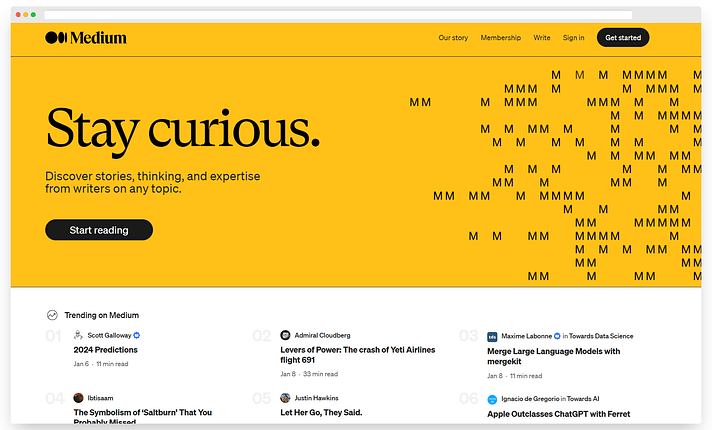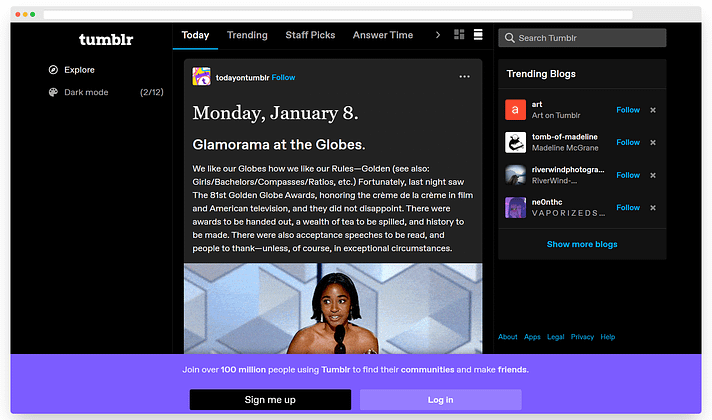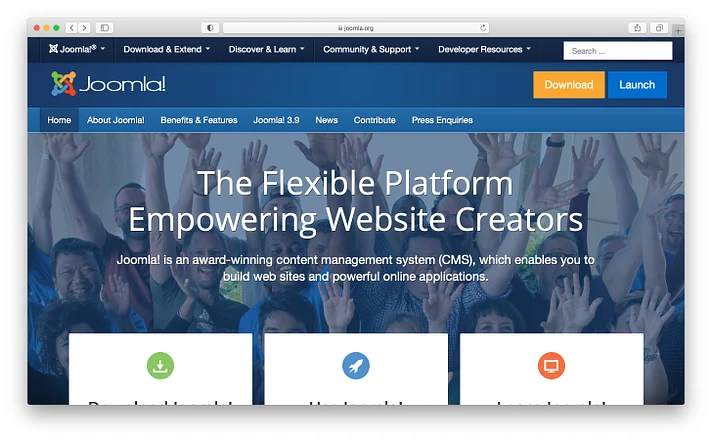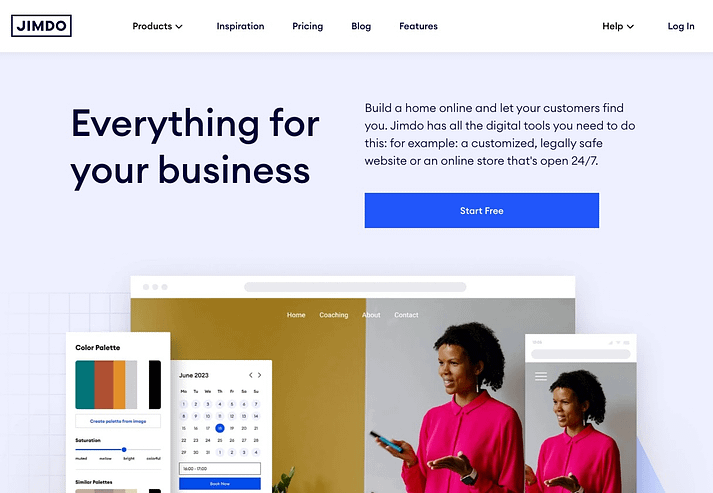In search of a few free blog platforms to get you started publishing your content online? We’ve compiled a list of ten fantastic websites where you can create a blog for free, regardless of whether your goal is to only share updates with your close friends and family or to gain more followers.
1. Wix

Wix is a free website and blog builder that is entirely controllable from the front end. This platform’s primary features are that it gives excellent drag-and-drop capabilities for working on your blog and a 100% free plan that allows you to start a blog under Wix’s subdomain.
Every Wix subscription also includes website hosting, saving you the trouble of looking for it elsewhere and allowing you to concentrate on organising your layouts, selecting a template, and creating content. For a variety of uses, including blogging, Wix also offers a good selection of both premium and free themes and designs. Both novice and expert users will find the platform’s general design to be highly user-friendly and contemporary.
To start a Wix blog, simply register and choose between building your own blog, which involves choosing a template and organising the layouts using the Wix editor, or letting the Wix ADI develop a site for you based on a questionnaire. If you choose the second option, all you have to do is select a lovely template and begin modifying things in live preview mode on the front end.
Your pages can have a variety of features added to them, such as forms, video boxes, backdrops, menus, typography, and multimedia widgets. Once you believe the site is prepared, click Publish to begin posting your stories to the blog. You can go back at any time after publishing to make changes to the content blocks.
2. WordPress

WordPress is a great option for anyone who wants to start a blog for nothing. It is an open-source platform with a plethora of configurable features. There are thousands of free themes and plugins available. This makes creating a distinctive, polished blog without any coding experience simple. Moreover, its vibrant community is always ready to lend support and guidance.
Although WordPress is free, you will need to register for a web hosting account in order to publish your website online. They are typically compensated. The files on your website are stored by this service and are available to online visitors. Making the switch from WordPress site creation to public sharing is an essential step.
Being the captain of your own ship is what it means to host the WordPress software on your own. You control your website’s appearance, usability, and ability to generate income. But every captain needs to be familiar with their ship. This entails a little more hands-on preparation that will give you a deeper comprehension of how your website functions. Accept the journey! It’s a necessary step on the road to blogging success.
3. LinkedIn

This one undoubtedly caught you off guard. Most people don’t choose LinkedIn initially when deciding which free blogging platform to use. Having said that, it is something that merits notice!
The pre-existing audience and the user-friendly technologies are the two primary causes of this.
Regarding the second point, the audience, LinkedIn’s user base excels since it consists of professionals, business owners, and individuals with a strong sense of purpose. Indeed, almost 60 million businesses are reportedly active on LinkedIn. Furthermore, they are not merely present for show. Forty percent of B2B marketers utilise the site as one of their main sources of leads, according to other data.
To put it briefly, LinkedIn serves as a platform for exposure. As a result, it ranks among the top free blogging platforms available online.
Technically speaking, publishing on LinkedIn is simple. Simply use the “Start a post” widget found at the top of your LinkedIn feed. Click on “Write an article on LinkedIn” to launch the full-screen editing window and turn your status update into a full post.
All of the editing tools you’re accustomed to, including those for adding photos and formatting text, are located here.
Read this comprehensive tutorial to find out more about how blogging on LinkedIn functions.
4. Weebly

Another website builder that you may use to sell things or display your portfolio in addition to blogging is Weebly. In that it offers a drag-and-drop WYSIWYG editor, it is comparable to Wix in certain ways. You may easily drag a button to the page and customise it if you wish to add one. Slideshows, photo galleries, and other multimedia components all suffer from this.
Sidebars, media boxes, forms, ad spots, social media icons, newsletter subscriptions, and a tonne of other features are all offered by Weebly. Additionally, the platform allows you to utilise your own customised domain (for a fee) and has built-in analytics.
Five personalised pages, a Weebly subdomain, 500MB of storage, and ad slots are all included in the free plan.
5. Medium

Anyone with an account on Medium, a multifunctional platform covering a wide range of topics, can write. With over 150 million monthly visitors (*) (and growing every year), Medium has a significant advantage over most other free blogging platforms in that your posts will reach a large readership.
It’s quite easy to use; all you have to do is sign up and begin writing. However, having all of your stuff on Medium is a drawback. That is, unlike with WordPress, you’re not actually creating your own “space.” For additional information on the variations between Medium and WordPress, see this post.
6. Ghost

This is an additional blogging platform similar to WordPress. Although you can download Ghost for free, you will need to pay for hosting in order to use it. Ghost is supported by DigitalOcean, a wonderful service that is affordable and has many useful features to get you started.
The drawback is that, depending on the host you select for your blog, installing Ghost is more difficult than installing WordPress and may require you to perform some server maintenance.
Once your website is up and running, creating a post in Ghost is simple. The editor features a live display of your writing on the right side of the screen and is straightforward and minimalist. It’s pleasant that the front end has a Medium vibe about it. You can select your preferences in the sidebar with options that is located close to the editing screen.
7. Blogger

Despite a decline in popularity in recent years, Blogger remains one of the most established free blog platforms.
While it’s a good option for personal blogs, it’s not the greatest tool for business use. It functions exactly like the other hosted platforms in that using it requires first creating an account. After creating it, which is quite easy, you need to select one of the pre-installed themes and begin jotting down your ideas. The editor on this platform resembles a Word document, and the UI is akin to a Google+ profile.
Blogger offers a wide selection of themes, each with unique skins, sophisticated colour filters, and a range of minimalist devices (also known as widgets). However, nothing overly complex or intricately customised. Blogger often offers basic settings for look. This means that your writing will receive more attention than a complicated design. This website has the excellent feature of offering ad slots that you may include in your content articles.
8. Tumblr

One of the first free blogging platforms on the internet is Tumblr. Just a little “milder” than the other items on the list, that is. This platform is geared more towards multimedia or social media-like content than the others, which were primarily made for publishing. Tumblr has an easier-to-use interface that is more lighthearted. All you have to do is register, after which you can begin posting.
Similar to a standard blogging platform, it offers many post forms for various kinds of content. Tumblr’s drawback is that it’s just meant for personal usage; if you have business-related goals, it might not be the best option. It is straightforward, provides some basic customisation possibilities, and, as I mentioned before, feels more like something from social media.
It’s not designed for businesses, but it does allow you to use affiliate links, put advertisements on your website, and link your blog to Google Analytics.
9. Joomla

Joomla and WordPress.org are comparable, though less evident given the abundance of free blog platforms. Similar to WordPress, the programme is free but requires a domain name and hosting. Similar to WordPress, Bluehost is highly advisable because to its affordability and dependability (plus, it comes with a free domain).
Generally speaking, Joomla offers a versatile interface that can be used for both more complicated websites and blogs (you may select from a range of templates and plugins to add specific features).
Regarding usability, the platform offers a traditional editor that resembles Microsoft Word in some way. You can select the background, tables, emoticons, font, colour, and size. The menu’s tools almost give the impression that you are in a Word window.
Joomla has tabbed editing. The traditional texting window itself is the first tab; to choose the post categories, tags, date, meta description, keywords, and other options, you must go between tabs.
10. Jimdo

As one might anticipate, Jimdo is a free tool for creating blogs. You create your website by providing Jimdo with a few brief guidelines on the kind of site you want to create and the style you want for the blog. Jimdo will automatically create your blog based on these responses.
You can publish your blog on Jimdo on its own subdomain (.jimdosite.com) if you choose to use the free plan. You will have to upgrade if you want a custom web address.
The distinctive quality of Jimdo is that it feels more like a “page builder.” The primary distinction is that, unlike with other blogging platforms, you compose your blog entries directly in the main customisation page of your website rather than in a separate editor. To make changes to content, choose the content box on the live website and make any necessary edits. All of this may be done without switching to a new page. This also allows you to edit the logo and footer of your website.
More customisation choices for your blog post can be found on the Jimdo interface’s left side. You can include information such as the post’s date, title, category, status (published or draft), summary, and preview image there. In essence, your post is composed of numerous separate sections that you can modify individually. You can choose the sequence in which these elements appear, and they include text, images, and buttons.
Read More :
Top 10 Destinations in Lakshadweep to See in 2024: A Travel Guide for Lakshadweep
Top 10 Attractions in Andaman & Nicobar


